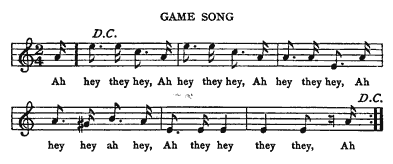Indian Guessing Games
by Alice C. Fletcher
Introductory Note.—Games of the "subjective" class, designated as guessing games by Dr. Culin, were generally accompanied by singing. There is a great variety in the games of this class, and five examples drawn from different
Indian games of this character do not always depend so much on chance as on the quickness of vision and skilful manipulation by the players. In games of this class the Indians never make random motions, all their movements, whether of the body, the feet, the hands or arms, being always in strict accord with the accompanying song, while the drama implied in the game is acted out, at the same time, more or less clearly. In these games the Indian players seem to be impelled by a common rhythmic and dramatic impulse, making a unity that enhances the interest and pleasure excited by the game.
I. Pu-in
Introductory Note.—This was a favorite game among the natives of the Northeastern States; its "strange whimsies" were first mentioned by William Wood in his book, "New England Prospect," published in London, 1634. It is probable that some form of this game still persists among the scattered descendants of those nearly extinct tribes, but it is not likely that at the present day the victor would proclaim his prowess, as was formerly done, by wearing in the holes of his ears the counters that marked the number of his successful guesses.
Properties.—A number of wheat or other straws cut about a foot long; a mat or blanket; a pointed staff for the Leader.
Directions.—Ten straws must be laid aside as counters for each player. The rest of the straws are separated into tens and each ten tied with a wisp, making a bundle; one bundle must have eleven straws. There should be as many bundles as players. The bundles must all be tied alike. The game consists in guessing which bundle has the eleven straws. The number of guesses allowed in a game must be fixed upon before starting to play.
All the bundles are thrown in a heap upon the center of the mat. The Leader, who is generally chosen by lot, leads the players to the mat containing the bundles. Each player holds in his left hand his ten counters and follows the Leader with his staff as he moves around the mat from left to right, while all sing the following song, taking steps to the rhythm of the music:
Game Song

When the Leader strikes his staff on the ground every player must stop just where he happens to be, stoop and pick up a bundle with his right hand and begin to wave it above his head and sway his body to the time of the song. When the Leader points with his staff to a player, that person must make a guess. As he scans the waving bundles he points with his left hand that holds his counters to the bundle which he thinks contains the eleven straws. If the guess proves to be correct, the guesser puts one of his counters in his hair or behind his ear. At once all bundles must be thrown in a heap on the mat. The Leader then moves forward by the left, followed by the players, every one singing and keeping time with the song. When the Leader strikes the ground with his staff, all halt. Each player immediately seizes a bundle, holds it aloft and begins to wave it. The Leader designates with his staff a person who must guess. If the guess is wrong, the guesser drops one of his counters on the mat and the Leader points to another player who must guess. If he loses, he drops one of his counters on the mat; the guessing goes on as described, until some one is successful and puts a counter in his hair, when the bundles are all thrown on the mat and the play begins again as before. Should the person designated by the Leader to guess think that he holds the bundle with eleven straws, he must point it at the Leader. If this surmise is correct, the person guessing puts a counter in his hair and all bundles are again thrown on the mat.
In this way the game proceeds until some player has won the requisite number of counters and has them all standing in his hair. Throughout the game the singing must be kept up, accompanied by rhythmic movements of the feet and the body, the players acting as though searching among the tall grass for a desired clump. When a point is won, the Leader should shout out the counter won, without interrupting the song or the play. Among the Indians the game, once started, is kept going without halt or break in the song or the movements. The calling out of the winnings in no way disturbs the singing or the playing.
The victor should wear his successful counters in his hair the rest of the day, if possible.